WHY 12 September 1897 IS A DAY OF PRIDE FOR ALL SIKHS
REMEMBERING THE BATTLE OF SARAGARHI
WHY 12 September 1897
IS A DAY OF PRIDE FOR ALL SIKHS
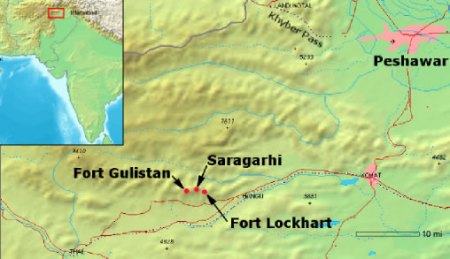
Battle of Saragarhi
The Battle of Saragarhi was fought during the Tirah Campaign on 12 September 1897 between 21 Sikhs of the 4th Battalion (then 36th Sikhs) of the Sikh Regiment of British India, defending an army post, against 10,000 Afghan and Orakzai tribesman in a last stand. The battle occurred in the North-West Frontier Province, now a part of Pakistan, which then formed part of British India.
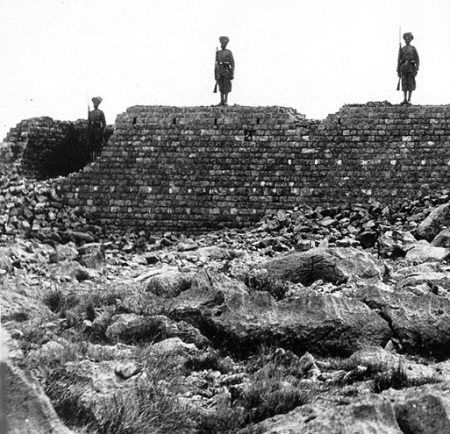
- Soldiers of the 36th Sikhs stand on the wall of the ruined building of Saragarhi which was burnt by Pathan tribesmen. All 21 of their colleagues die
Battle of Saragarhi is the incredible story of 21 men of the 36th Sikh Regiment (currently the 4th Sikh Regiment) who gave up their lives in devotion to their duty. This battle, like many others fought by the Sikhs, highlights the heroic action by a small detachment of Sikh soldiers against heavy odds.
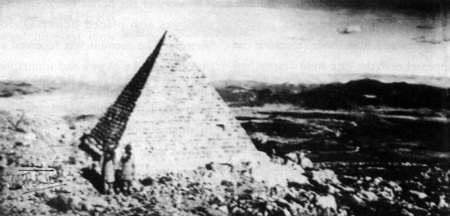
Cairn on the Site of Saragarhi Post
This encounter took place on 12 September 1897 in the Tirah region of North-West Frontier Province (now in Pakistan, which then formed part of British India). In keeping with the tradition of the Sikh Army, they fought to the death rather than surrender.

Saragarhi Poster
The Battle at Saragarhi is one of eight stories of collective bravery published by UNESCO (United Nations Educational, Scientific and Cultural Organization). It has been mentioned as one of the five most significant events of its kind in the world which includes the Saga of Thermoplyae associated with the heroic stand of a small Greek force against the mighty Persian Army of Xerxes in 480 B.C.

Hav. Isher Singh, commanded the Saragarhi post
On September 12, 1897 about 10,000 Afridis and Orakazais tribesmen swarmed towards Saragarhi, while another group cut off all links from Forts Gulistan and Lockhart. For the next six hours the small detachment of 21 men led by Havildar Ishar Singh stood firm and repulsed all attacks. With passage of time the ranks of the Sikhs started getting thinner and their ammunition was running out. But they never faltered and continued to punish the enemy. The enemy succeeded in making a large breach in the outer wall and swarmed in, the Sikhs fought to the last man.
The heroes of Saragarhi, barely 21 in number, belonged to the 36th Sikhs, since re-designated as 4th Battalion of the Sikh Regiment of the Indian Army. During a general uprising of the turbulent Pathan tribals of Tirah in 1897, the battalion was deployed to defend Samana Ridge, a hill feature 8 km in length separating the Kurram and the Khanki valleys. The headquarters and four companies were located in Fort Lockhart at the eastern end of the ridge and the other four companies in Fort Cavagnari, commonly known as Gulistan, at its western end, with several smaller outposts at different strategic points.
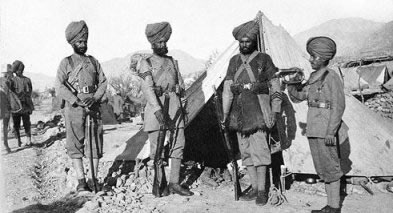
The 36th Sikhs were raised in 1887 at a time when Russian expansion was feared and the North-West Frontier needed strong fortification. Their brief history is notable for one action that ocurred in 1897
Saragarhi was a small picket perched on a rockyrib cropping up transversely across Samana Ridge halfway between Fort Lockhart and Gulistan preventing direct communication between the two bases. Overlooking both the wings, Saragarhi, manned by only 20 sepoys (riflemen) and one noncombatant sweeper under the command of Havildar (sergeant) Ishar Singh, was tactically a vital post for communication which in those days was possible only through visual signalling.
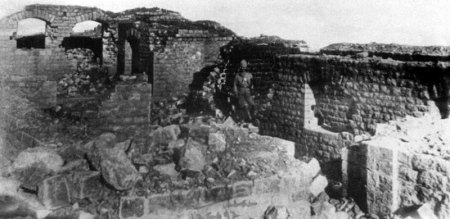
The burnt-out interior of Saragarhi where the bodies of 21 brave men of the 36th Sikhs were found on the 14th September after the seige on 12th
The Orakzai and Afridi tribesmen, 10 thousand strong, attacked Gulistan twice on 3 and 9 September but were repulsed with heavy losses on both occasions. Chagrined at the reverses, they looked for a smaller target to ensure easy success.
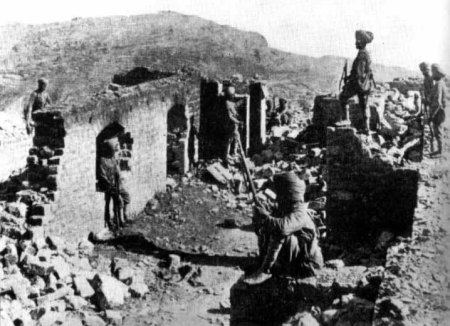
The ruins of the Saragarhi signal post, defended to the last by Havildar Ishar Singh and his 20 men of the 36th Sikhs. Fort Lockhart is on the skyline
On the morning of 12 September 1897, they fell upon Saragarhi, a small square, stone block house, and surrounded it making any reinforcement to the besieged impossible.
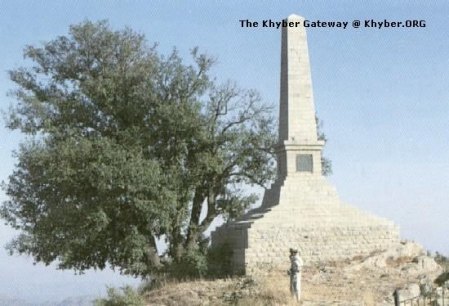
The inscription on the monument mentions the names of the 21 Sikhs who were killed while garrisoned in a little-known fort named Saragarhi Fort
Havildar Ishar Singh and his men, undaunted by the hopeless situation they were in, fought back with grim determination. The incessant fire from the besiegers took its toll, and after a 6 hour long battle, the only soldier left alive was the signaller, Sepoy Gurmukh Singh, who had meanwhile kept the battalion headquarters informed about the situation through messages flashed by flag.

The inscription on the monument mentions the names of the 21 Sikhs who were killed while garrisoned in a little-known fort named Saragarhi Fort.
At last asking for permission to stop signalling he took up his rifle to join combat. He fell fighting single-handed.
THE 21 SIKHS WHO GAVE THEIR LIVES SO OTHERS COULD LIVE FREE LIVES, MY SALUTE TO YOU!
Havildar Ishar Singh (165)
| Naik Lal Singh (332) | Sepoy Nand Singh (1221) | Naik Lal Singh (332) |
| Sepoy Narayan Singh (834) | Lance Naik Chanda Singh (546) | Sepoy Gurmukh Singh (814) |
| Sepoy Sundar Singh (1321) | Sepoy Jivan Singh (871) | Sepoy Ram Singh (287) |
| Sepoy Gurmukh Singh (1733) | Sepoy Uttar Singh (492) | Sepoy Ram Singh (163) |
| Sepoy Sahib Singh (182) | Sepoy Bhagwan Singh (1257) | Sepoy Hira Singh (359) |
| Sepoy Bhagwan Singh (1265) | Sepoy Daya Singh (687) | Sepoy Buta Singh (1556) |
| Sepoy Jivan Singh (760) | Sepoy Jivan Singh (1651) | Sepoy Bhola Singh (791) |
August 11, 2010 at 3:26 am
Incrediable story – good that you have highlighted this – the world needs more insipring stories like this
July 20, 2013 at 12:41 pm
i am proud to be a sikh. Thanks to admin for posting about this historical event of imence bravery of SIKH regiment. I wish every single ïndian had read this story.